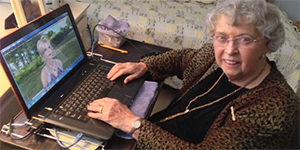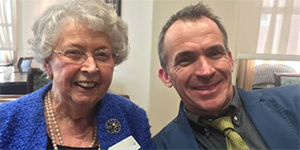A (virtual) world without Parkinson’s

A (virtual) world without Parkinson’s
- September 24, 2015
- Anthropologist studies how people with disabilities make use of new online technologies
 Fran entered the Phantom of the Opera Masquerade Ball dressed to the nines. Her blue
gown swayed with her eloquent movements; her necklace glittered when it caught the
light. She danced effortlessly, song after song, never stumbling or faltering in her
rhythm. It was a great evening. Maybe even more so, because Fran was at her computer
and the location of the ballroom doesn’t exist on any Google map. The experience happened
in the virtual world Second Life, where Fran often spends time with her friends. When
the 88-year-old gets up from her computer, she may have trouble standing. Fran has
Parkinson’s disease and struggles some days to lift her legs enough to walk. But in
Second Life, she dances, goes horseback riding, takes walks on the beach. To her,
these experiences are every bit as real as the “real world.”
Fran entered the Phantom of the Opera Masquerade Ball dressed to the nines. Her blue
gown swayed with her eloquent movements; her necklace glittered when it caught the
light. She danced effortlessly, song after song, never stumbling or faltering in her
rhythm. It was a great evening. Maybe even more so, because Fran was at her computer
and the location of the ballroom doesn’t exist on any Google map. The experience happened
in the virtual world Second Life, where Fran often spends time with her friends. When
the 88-year-old gets up from her computer, she may have trouble standing. Fran has
Parkinson’s disease and struggles some days to lift her legs enough to walk. But in
Second Life, she dances, goes horseback riding, takes walks on the beach. To her,
these experiences are every bit as real as the “real world.”
“To say Fran’s experience isn’t happening in the real world is false,” says Tom Boellstorff, anthropologist and author of Coming of Age in Second Life, second edition released this month. “Virtual worlds are online places of culture that impact life in the physical world. Online and offline can both be real. Many of Fran’s experiences in Second Life are very real, and similar to the experiences of many persons with disabilities who have gravitated toward virtual worlds for social interaction and creative outlets.”
 Fran is one of several people Boellstorff is working with closely as part of a newly
funded $276,900 National Science Foundation study. He’s conducting interviews – both
in virtual and the physical world – to better understand how online environments impact
social interaction and self-understanding as well as physical world experiences of
disability. He’s also interested in learning which aspects of online social interaction
are linked to specific disabilities and how differing platforms and devices are used.
Fran is one of several people Boellstorff is working with closely as part of a newly
funded $276,900 National Science Foundation study. He’s conducting interviews – both
in virtual and the physical world – to better understand how online environments impact
social interaction and self-understanding as well as physical world experiences of
disability. He’s also interested in learning which aspects of online social interaction
are linked to specific disabilities and how differing platforms and devices are used.
“Billions of people now use online environments – social network sites like Facebook, games, virtual worlds,” he says. “Since some early human first picked up a stick to use as a cane, persons with disabilities have been at the forefront of technology innovation, so it’s natural that they would be doing creative things in virtual worlds, too."
Second Life is one such place where persons with disabilities are innovating new uses of the platform. Now eleven years old, the virtual world has around one million active users. Boellstorff was one of the early adopters; after writing two books about Indonesia, he wanted to challenge himself and try something new.
“I really liked technology and virtual worlds were this new realm I thought would be fun to try out.”
As Tom Bukowski in Second Life, he started running into people with disabilities early on.
He encountered people with amazing stories, like DB, an architect who, prior to being diagnosed with Parkinson’s in the early 2000s, collaborated on the design of Los Angeles’s Disney Concert Hall. When his disease made it too hard for him to continue his work in the physical world, he discovered Second Life and has used the virtual platform as his creative outlet, designing structures that would be impossible to build in the physical world.
He also met Solas, a clothing designer whose Parkinson’s complications took her out of the fashion industry. When she discovered Second Life, her designs came alive again in ways she could never have imagined in the physical world. She’s now a well-known clothing designer in Second Life, creating sought-after fashion for avatars. The online community helped her to overcome the feeling of isolation persons with disabilities commonly experience, and it gave her a creative outlet to be productive again.
“Solas made a comment one day: ‘I feel more comfortable in Second Life, because people don’t see me shaking... I don’t have Parkinson’s in Second Life and that makes me so happy.’ This view isn’t limited to her experience, it’s echoed by many with disabilities whom I’ve encountered in virtual worlds,” Boellstorff says.
In some instances, persons with disabilities have reported positive changes in their physical world following their time in a virtual space. Fran is among this group, claiming that Second Life has helped her regain better mobility. While Boellstorff isn’t a medical doctor and isn’t studying this aspect, he thinks it is very interesting and could be a course of study for future medical trials.
“Disability is a fascinating category of human experience because anyone can enter it at any moment – we’re all just a car accident away. And even if we avoid it, if we live long enough, age will present us with obstacles that limit our ability to function as we currently do.”
“Studying how people adapt through the use of technology helps advance the public conversation on disability and digital technology.”
Funding for this study began in July and will run through June 2018.
-Heather Ashbach, UCI Social Sciences Communications
-pictured (top left to bottom right): Bill and Fran as their Second Life avatars (courtesy
of Anthea Beletsis). Fran at her computer with her avatar. Bill and Fran.
Share on:


connect with us: